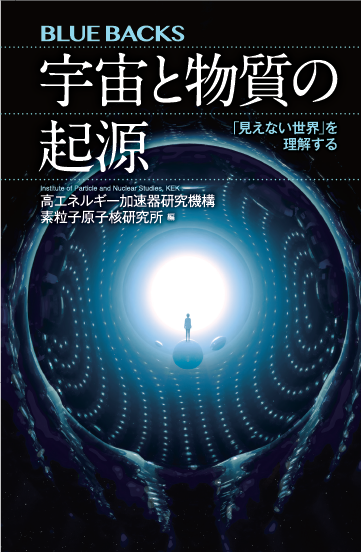Preface
This section explains the intention behind writing this book and why the braille edition was created. It also introduces the “Cosmic Calendar,” which maps the events that occurred over approximately 13.8 billion years of the universe’s history to a single year, based on the latest findings.
Author
Naohito Saito, Director, Institute of Particle and Nuclear Studies, High Energy Accelerator Research Organization
Chapter 1
“What is the Universe Made Of?”
This chapter provides a glossary of terms to help readers understand the book. It explains how the 118 elements known to humanity are composed of just three types of particles: electrons, up quarks, and down quarks. These are currently considered indivisible fundamental particles, and experiments using accelerators have shown that more types of particles exist in the universe.
Author
Junpei Fujimoto, Senior Fellow, Institute of Particle and Nuclear Studies, High Energy Accelerator Research Organization
Chapter 2
“The Beginning of the Standard Model of Particle Physics”
Following Chapter 1, this chapter explains the so-called “Standard Model of Particle Physics” that humanity has developed over the past 100 years. The Standard Model features 17 types of particles. One of its predictions, the Higgs boson, was discovered in 2012 in experiments at the Large Hadron Collider (LHC) of the European Organization for Nuclear Research (CERN), and research on all 17 types of particles continues.
Author
Junpei Fujimoto
Chapter 3
“The Origin of Elements”
This chapter explains how the 118 known elements were created in our universe and their abundance ratios.
Authors
Yuya Miyatake, Diamond Fellow, Institute of Particle and Nuclear Studies, High Energy Accelerator Research Organization
and
Kazunori Kohri, Professor, National Astronomical Observatory of Japan; Special Professor, Institute of Particle and Nuclear Studies, High Energy Accelerator Research Organization
Chapter 4
“The Origin of Mass”
As explained in Chapter 2, the Standard Model of Particle Physics posits that all particles had zero mass at the birth of the universe. Chapter 4 revisits the “origin of mass” and explains that the mass of protons and neutrons, which make up most of an atom’s mass, is given by a mechanism different from the Higgs field.
Author
Shoji Hashimoto, Professor, Institute of Particle and Nuclear Studies, High Energy Accelerator Research Organization
]Chapter 5
“The Origin of Forces”
This chapter explains the concept of “unification of forces,” one of the goals of the particle physics, and how the Standard Model of Particle Physics achieved this unification for the electromagnetic and the weak forces through the “gauge principle.” It also discusses the ongoing quest for a “Grand Unified Theory” that would truly unify three forces adding the strong force.
Author
Junpei Fujimoto
Chapter 6
“The Origin of Asymmetric Universe: Matter and Antimatter”
This chapter explains experiments related to the existence of antimatter. According to the Standard Model, particles have corresponding antiparticles. However, observations of the universe show that most particles exist as matter, with antiparticles appearing only briefly. The Kobayashi-Maskawa theory explains the differences in properties between particles and antiparticles and has been validated by experiments at KEK’s accelerator and concurrent U.S. accelerator experiments. The chapter also describes ongoing experiments to further understand this asymmetry, including the T2K experiment, which observes neutrino changes from J-PARC to the Super-Kamiokande in Gifu Prefecture.
Authors
Sho Tada, Associate Professor, Institute of Particle and Nuclear Studies, High Energy Accelerator Research Organization
and
Shintaro Ito, Assistant Professor, Kitakyushu National College of Technology
Chapter 7
“The Origin of Cosmic Expansion”
Starting with an overview of the universe’s size, this chapter explains the “big bang” model proposed by Dr. Gamow and addresses issues like the “horizon problem,” “flatness problem,” “origin of density fluctuations,” “monopole problem,” and “gravitino problem.” It introduces the “inflation” theory, which posits that the universe underwent rapid expansion shortly after its birth, potentially driven by the hypothetical “inflaton” particle, and discusses experiments aimed at proving inflation.
Author
Kazunori Kohri
Chapter 8
“The Origin of Large-Scale Structure in the Universe: Dark Matter and Dark Energy”
This chapter explains dark matter, which is believed to shape the large-scale structure of the universe and determine its fate, through three cosmological observations. It also discusses four theoretical candidates for dark matter and how to detect them. The chapter then covers dark energy, which makes up about 70% of the current universe, exploring its theoretical explanations and the implications for the universe’s future, including the “multiverse and anthropic principle” as a solution to related issues.
Author:
Kazunori Kohri
Chapter 9
“The Origin of Cosmic Evolution”
Just as life evolves, so does the universe. This chapter explains the concept of cosmic evolution, focusing on “vacuum phase transitions” caused by “spontaneous symmetry breaking,” a mechanism by which the universe, starting as a point of energy, evolves into increasingly complex structures. It also covers the ATLAS experiment at CERN’s LHC, which was instrumental in discovering the Higgs boson.
Authors
Soshi Tsuno, Associate Professor, Institute of Particle and Nuclear Studies, High Energy Accelerator Research Organization
and
Yu NakahamaU, Associate Professor, Institute of Particle and Nuclear Studies, High Energy Accelerator Research Organization
Chapter 10
“Is the Universe Stable?”
The main theme of this book is to elucidate the origins of the universe and matter. While previous chapters primarily explained past events revealed through experiments, this chapter revisits the “quantum field theory” underlying particle physics and discusses the relationship between the masses of the Higgs boson and the top quark in the context of vacuum stability. Current LHC measurements suggest the vacuum is on the border between stability and metastability, implying a potential “end of the world” scenario if the vacuum is unstable. However, this discussion is contingent on the Standard Model, and any contradictory experimental results would nullify these predictions.
Author
Keisuke Fujii, Visiting Professor, Iwate University; Emeritus Professor, Institute of Particle and Nuclear Studies, High Energy Accelerator Research Organization


